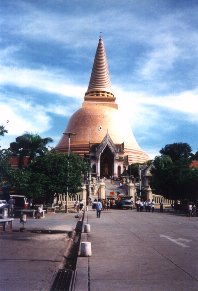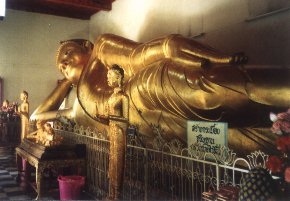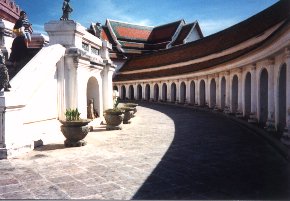Phra Pathom Chedi |
A little illustrated
guide to Thailand's First Buddhist Monument
(from a visit in 1988)
About 60km to the West of Bangkok, in the town of Nakhon Pathom, stands probably the earliest Buddhist monument in Thailand, Phra Pathom Chedi. A few years ago, I had the great pleasure of visiting this place of worship and (even) took some photos. Recently, a friend sent me an official guide, published by the 'Office of Utility Management and Maintenance of the Great Pagoda'. Now that I have scanned in a few of my photos, I thought I'd take the opportunity of presenting a little tour to indicate especially how old are the roots of Buddhism in Thailand and also how the Buddha Dhamma can be seen in practice in such places. The historical notes are taken from the official guide.
The roots of this pagoda are over 2000 years old. During his reign in India in the 3rd Century before Jesus Christ (B.C.), Emperor Asoka sent out missionaries to lands far away. One of these was what is presently Thailand, at that time called Suvarnaphumi. The evidence for this has been provided by the discovery of stone wheels of law (Dharmachakra), carved altars and the Buddha's footprints, all of which preceded the making of the first Buddha rupas (images) in 143 B.C.
Phra Pathom Chedi means 'The First Stupa' (Phra used here as emphasis for the sense of 'holy'). The original stupa was 39 metres high and built in the style of the great stupa at Sanchi. It is considered sacred since it contains some relics of the Buddha Gotama that were brought over by the early missionaries. The orginal monument is still there, but has since been built over and restored under the guidance of various monarchs. This is indeed a very special chedi for the rulers of Thailand, since it has been the royal tradition the reigning monarch must offer candles and joss sticks whenever passing Phra Pathom Chedi.
 |
The present monument, is the realisation of the wish of King Mongkut, Rama IV, who, as a prince had been several times on pilgrimage to the stupa as a monk. At that time the stupa had fallen into decay, so the prince resolved to restore it. When he acceded to the throne, he therefore instructed its restoration by building an enormous chedi as a protective cover of the existing one. This proved a difficult task - the first attempt collapsed in bad weather. However, in due course this was achieved and in 1870, the spire was raised during the reign of his successor, King Chulalongkorn. |
Today, the chedi lies at the heart of a town that celebrates its 100th anniversary this year (the name Nakhon Pathom replacing Nakorn Chaisri somewhat later). Before 1897, the stupa was in the midst of jungle, so King Chulalongkorn ordered Nakorn Chaisri to be transplanted a couple of miles! The pagoda is generally approached from the North side along an extended avenue. Even from far away one gains an impression of the large scale. At 120 metres in height, it was the tallest Buddhist monument in the world, perhaps it still is?
Moving closer, one approaches marble steps that lead up towards the North vihara (or chapel) and there looms the image of a standing Buddha.
| In Thai Buddhism, it is considered a great merit to restore any articles or images that serve to remind one of the Buddha and his teachings. Thus it is often recorded how the Thais - members of the Sangha and lay people - have dutifully restored Buddha rupas. This standing Buddha is an excellent example: in 1909 Crown Prince Vajiravudh [later Rama VI] discovered it damaged and buried in the ground. He had it dug up, inspected it, and found it had some parts in good condition; since he liked its character, he ordered its restoration and awarded it the title 'Phra Ruang Rojanaridhi Sri Indaratitaya Dharmobas Maha Vajiravudha Rajapujaniya Borpitra'. It was installed at its present location in 1915; and, in accordance with his wishes, King Vajravudh's ashes were installed there after he passed on. |  |
Moving further in, concentric with the central stupa is a surrounding gallery or portico that connects the four viharas:
|
I was delighted to see these being used for Dhamma study by some monks and was kindly granted permission to take a few photos of the Venerable Ajahn (teacher) and his students, young monks. I am very happy to see such an ancient centre of Buddhism so full of Dhamma-related activities.
 |
 |
The writing on the blackboard says:
You are invited to listen to dhamma by 3 people who are specialists
in the topic of: The benefits of studying well.1. Phra Ajahn Daoloy [can't see the name clearly]
2. Phra Ajahn Nuuka
3. Samanera Teerapong
Many thanks to Khun Jo for the translation!
There is a vihara for each of the four points of the compass, with Buddha rupas in each. However, I took few photos in these. One exception is the following view of a huge reclining Buddha, which is traditionally meant to show the posture of the Buddha as he passed on - fully Awakened!
 |
There are numerous other features including the architecture of the chedi and some special bell booths in the pagoda yard, completing this as one of the most important religious sites in Thailand. If you happen to be touring Thailand, then please try to pay a visit and may it inspire you to build up your own Buddhist practice!
Links to Chedis and Pagodas
Stupas This is an interesting index to the wide range of stupas of old, more recent, and those currently under construction. It has pointers to all kinds of relevant resources.
The Great Stupa at Sanchi A few historical notes on this most famous stupa.
Angkor Wat - Royal Angkor Foundation at the Department of Geoinformatics College of Surveying and Land Management, University of Sopron
This ancient Wat of Cambodia is one of several hundred monuments that have been targeted by the World Heritage Organisation. These informative pages show how environmental considerations are important to preserve ancient religious sites.
Architectural Drawings of Temples in Bagan. Bagan is the most important architectural complex in Myanmar (Burma). It contains the famous Shwezigon pagoda that also is based on the great stupa at Sanchi. These pages provide detailed information on the art and architecture, another expression of Buddhist practice.
Buddhist Art and Architecture A guide by BuddhaNet, which includes illustrated explanations of the various symbolic hand gestures (mudras) that are represented in the Buddha rupas.
Missing links..Last time I tried (23 Aug 98), I couldn't locate the following useful information, so if anyone knows where these pages have gone, please let me know. Thanks.
Phra Pathom Chedi Some further on-line information provided by ,with some related links, e.g. to the Museum attached to the pagoda. This is part of a guide to Nakhon Pathom provided by Silpakorn University.
In a future edition, if you would like, we can look more at Buddhist monuments and/or the
history of Buddhism in various parts of the globe.
Note
This article was originally one of a series of contributions I made as a 'Buddhist
Guide' for the Mining Company.
Index to articles | Index
to books | Main Index | Paul's
Home page
- Paul Trafford
